
Dating back to 1853 anaglyphs now is a widely known way to experience three-dimensional vision both among kids and adults. Anaglyphs are stereoscopic images produced by superimposing the left and the right eye images. Each image is colored differently, thus they are filtered by special glasses with two-colored lenses for each of our eyes. Those glasses known as anaglyph 3D glasses transmit two separate images to the brain. In its turn our brain perceives such two images as one, merging them into “three-dimensional” image. Viewing the depth in anaglyph images is possible only through anaglyph 3D glasses. So which ones are right to choose?
As you already know anaglyph 3D glasses work as filters to view the three-dimensional effect in anaglyph images. The main principle, on which anaglyph glasses and anaglyph imaging in general are based, is called trichromacy. This basis presumes that there are three primary colors of red, green and blue, which act as the filters for our eyes. The important fact is that two eyes should not both have any of those colors, because in that way ghosting occurs and the depth won't be perceived correctly.
Knowing this we can define six possible combinations of colors for pure anaglyph images: red-green, red-blue, green-blue, red-cyan, green-magenta and blue-yellow. These color schemes are mostly used, however nowadays many companies have developed and patented their own color schemes, which reduce amount of ghosting in one or both eyes. So let's have a look at the types of anaglyph 3D glasses, which are present in the market today!
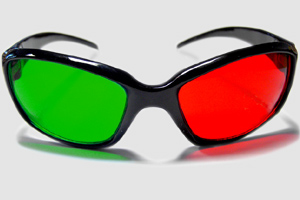 Red-green anaglyph glasses
Red-green anaglyph glassesWith pure red left lense and pure green right lens these are the predecessors of red-cyan anaglyph glasses. The main disadvantage of red-green anaglyph glasses is that green filter lets too much red color through so some ghosting can be present when viewing anaglyph imagery.
 Red-blue anaglyph glasses
Red-blue anaglyph glasses
These glasses have pure red left lens and pure blue right lens. No disadvantages in viewing anaglyph images, because the filters let through colours, which don't overlap. So no ghosting is present.
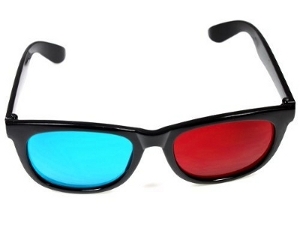 Red-cyan anaglyph glasses
Red-cyan anaglyph glasses
Most common type of anaglyph 3D glasses in the market today. Having pure red left lens and pure cyan (gree+blue) right lens, images for this types of glasses are available in full version (only red color in the red channel) and half version (less retinal rivalry)
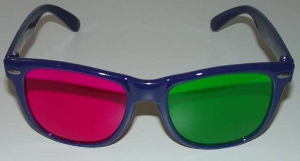
Trioscopic green-magenta anaglyph glasses
These glasses are somewhat newer than red-cyan, but the same principle. The glasses have pure green left lens and pure magenta (red+blue) right lens. The main advantage of these glasses is that there's less chromatic aberration, because blue and red colors in magenta balance well with green.
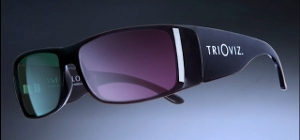 Inficolor magenta-green anaglyph glasses
Inficolor magenta-green anaglyph glasses
This stereoscopic system developed by TriOviz company comprises complex magenta left lens and complex green right lens. The main plus of these anaglyph glasses is that they allow a natural color perception alongside fine 3D experience.
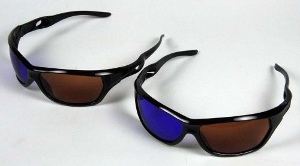 ColorCode yellow-blue anaglyph glasses
ColorCode yellow-blue anaglyph glasses
These anaglyph glasses are also known as ochre-blue or brown-blue, because they have amber (red+green+grey) left lense and pure dark blue right lens. The biggest vice is that output image is very dark. So anaglyph imagery should be viewed either in the dark room, or this input image should be very bright in order to see it through yellow-blue glasses.
 Infitec anaglyph glasses
Infitec anaglyph glasses
Last on our list are Infitec anaglyph glasses, which have white left and right lenses. These anaglyph glasses use special interference filters and require corresponding interference filters for projectors. The main advantage is that Infitec anaglyph glasses allow to perceive anaglyph imagery in full color. But unfortunately, this system can't be used with standard LCD, CRT or other displays.
So this is our brief look on the types of anaglyph 3D glasses, which are all available for you to enjoy all kinds of anaglyph 3D images. But if you're looking for advice, we would recommend you to stay true to classic model and choose red-cyan anaglyph glasses: they are the most common type, that's why there's a lot of anaglyph imagery and video material for experiencing 3D through these red-cyan glasses. Plus the ghosting is very unlikely to be present when viewing in red-cyan anaglyph 3D glasses.
Put on anaglyph red-cyan 3D glasses and enjoy any video in 3D format with 3D Video Converter! Convert favorite video or movie to HD 3D video - just download your free trial version and start enjoying 3D experience now! If you want to watch any video in 3D format on the fly you can do that with powerful 3D Video Player. Get your free trial of 3D Video Player now!
| Get your social on: |
|
Tweet |
|
||
Read Next -> Cyclops are coming with virtual-reality Sony 3D headgear
<- Back to 3D Media Revolution Blog
